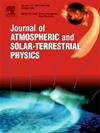评估南美洲上空大气柱的温度和水蒸气:利用ERA5再分析确定趋势的概要
IF 1.9
4区 地球科学
Q3 GEOCHEMISTRY & GEOPHYSICS
Journal of Atmospheric and Solar-Terrestrial Physics
Pub Date : 2025-04-17
DOI:10.1016/j.jastp.2025.106514
引用次数: 0
摘要
气候变化已经成为全球的现实。一些研究量化了这些变化如何影响特定的能量收支成分,如辐射通量、热储存和能量传递过程,并与若干气候变量的已证实的变化相关联。鉴于热力过程在水文循环中的关键作用,本文旨在全面概述整个南美洲大气柱的气温和水蒸气气候学。此外,利用再分析数据在当前气候条件下分析了这些变量的检测趋势,重点关注IPCC第六次评估报告(AR6)所定义的区域。结果显示,在整个大陆的大气的所有层次上,气温都有上升的趋势。气温上升速度最快的是南美洲中部地区,而在较高水平上,该大陆北部地区的变暖速度更为显著。整个大气柱的水汽有增加的趋势,特别是在南美洲北部。确定的东南地区水汽和比湿的减少趋势在统计上没有显著的信号。这种观测到的变化引起全球和区域环流模式的改变,主要与极端事件有关。本文章由计算机程序翻译,如有差异,请以英文原文为准。
Assessing temperature and water vapor in the atmospheric column over South America: a synopsis of identified trends using ERA5 reanalysis
Climate change is already a reality globally. Several studies have quantified how these alterations affect specific energy budget components, such as radiative fluxes, heat storage, and energy transfer processes, correlating with verified modifications in several climate variables. Given the crucial role of thermodynamic processes in the hydrological cycle, this paper aims to provide a comprehensive overview of the climatology of air temperature and water vapor throughout the atmospheric column across South America. Moreover, detected trends in these variables are analyzed in the present climate using reanalysis data, focusing on the regions defined by the IPCC's Sixth Assessment Report (AR6). The results reveal an increasing air temperature trend at all levels of the atmosphere over the continent. The highest rates of air temperature rise are in the central portion of South America, while at high levels, the rate of warming is more significant in the northern part of the continent. There is an increasing trend in water vapor throughout the atmospheric column, particularly in the northern sector of South America. The identified decreasing trends of water vapor or specific humidity in the southeastern region do not exhibit a statistically significant signal. Such observed changes cause alterations in global and regional circulation patterns, mainly associated with extreme events.
求助全文
通过发布文献求助,成功后即可免费获取论文全文。
去求助
来源期刊

Journal of Atmospheric and Solar-Terrestrial Physics
地学-地球化学与地球物理
CiteScore
4.10
自引率
5.30%
发文量
95
审稿时长
6 months
期刊介绍:
The Journal of Atmospheric and Solar-Terrestrial Physics (JASTP) is an international journal concerned with the inter-disciplinary science of the Earth''s atmospheric and space environment, especially the highly varied and highly variable physical phenomena that occur in this natural laboratory and the processes that couple them.
The journal covers the physical processes operating in the troposphere, stratosphere, mesosphere, thermosphere, ionosphere, magnetosphere, the Sun, interplanetary medium, and heliosphere. Phenomena occurring in other "spheres", solar influences on climate, and supporting laboratory measurements are also considered. The journal deals especially with the coupling between the different regions.
Solar flares, coronal mass ejections, and other energetic events on the Sun create interesting and important perturbations in the near-Earth space environment. The physics of such "space weather" is central to the Journal of Atmospheric and Solar-Terrestrial Physics and the journal welcomes papers that lead in the direction of a predictive understanding of the coupled system. Regarding the upper atmosphere, the subjects of aeronomy, geomagnetism and geoelectricity, auroral phenomena, radio wave propagation, and plasma instabilities, are examples within the broad field of solar-terrestrial physics which emphasise the energy exchange between the solar wind, the magnetospheric and ionospheric plasmas, and the neutral gas. In the lower atmosphere, topics covered range from mesoscale to global scale dynamics, to atmospheric electricity, lightning and its effects, and to anthropogenic changes.
 求助内容:
求助内容: 应助结果提醒方式:
应助结果提醒方式:


